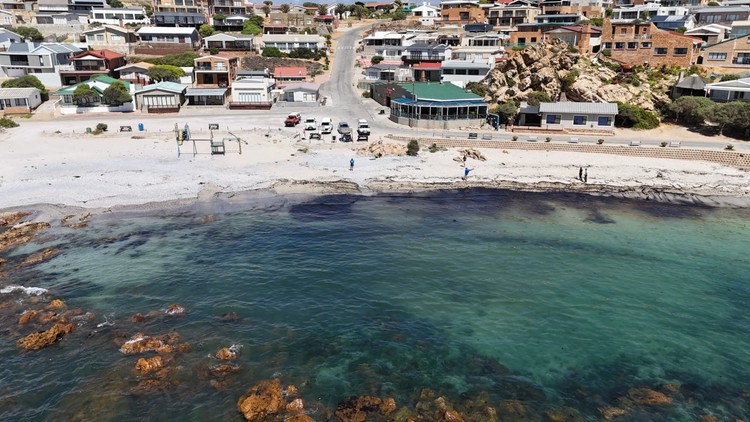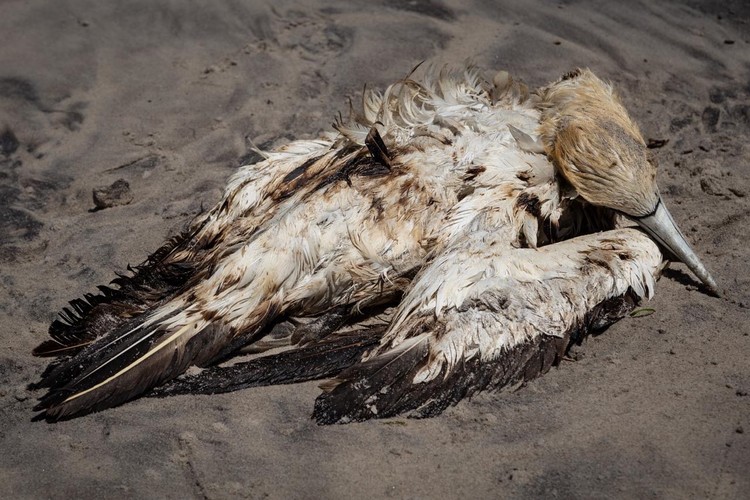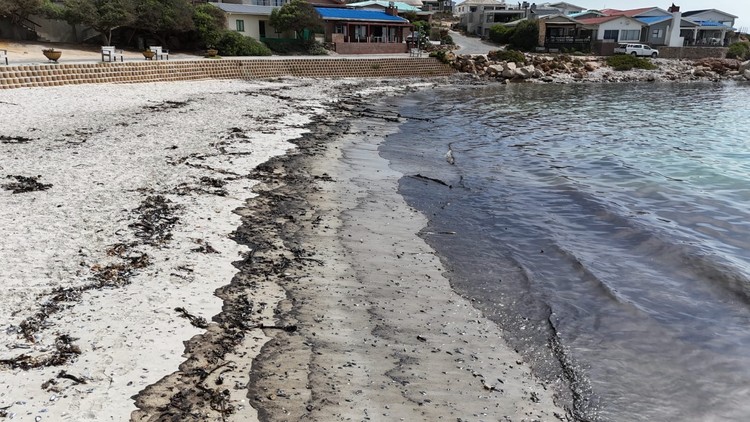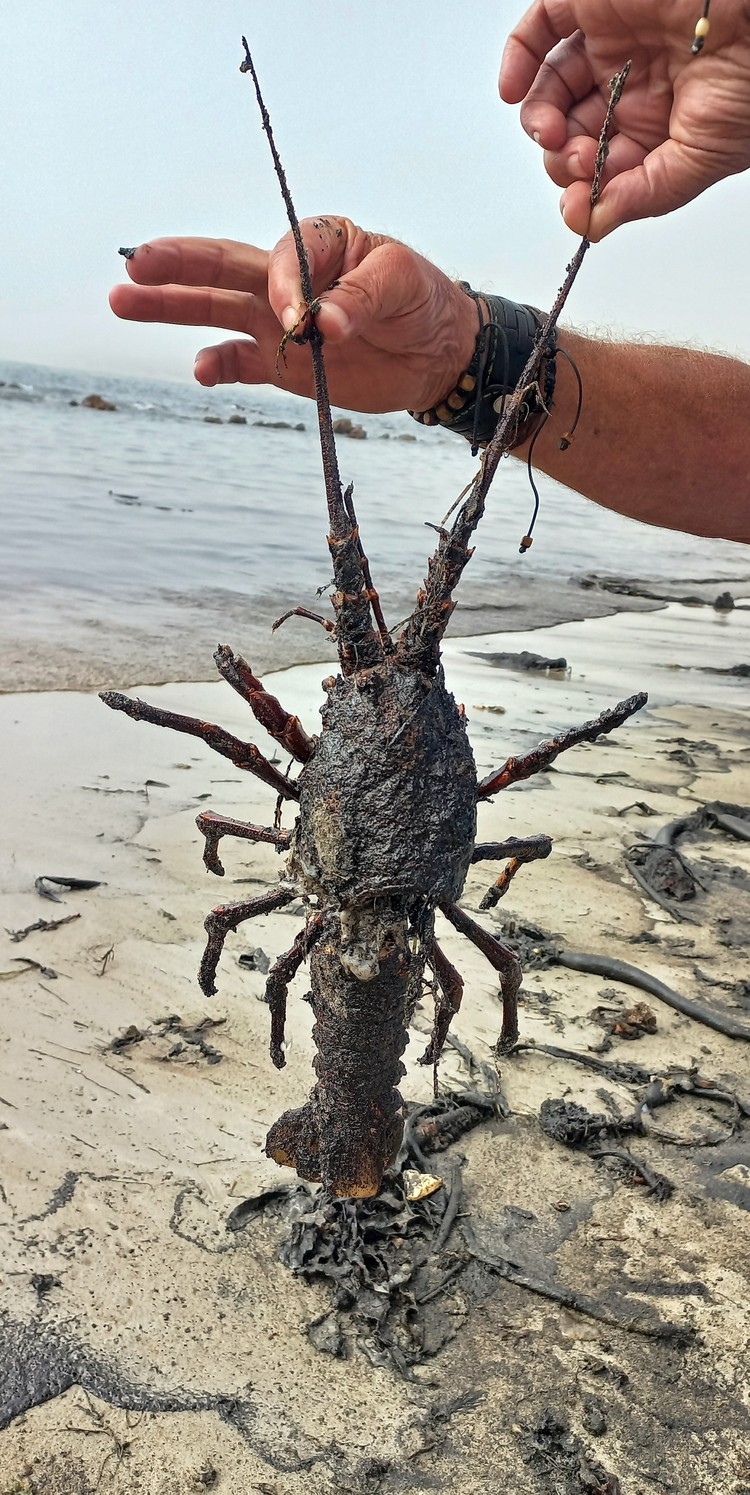West Coast beaches polluted by oil spill
Source of the oil not yet confirmed, but locals suspect the wreck of the MV Ultra Galaxy
A drone image of oil at the main beach in Strandfontein on the West Coast. Photo: Tania Fouche
- About 40km of West Coast beaches have been polluted by an oil slick which also threatens sea bird colonies and the Olifant’s River estuary.
- Bird conservation group SANCCOB is on high alert to the “developing situation” but no live oiled birds have been reported yet.
- Clean-up teams have been in action on beaches since last Thursday.
A patchy oil slick, estimated at about 20km long and first seen just over a week ago, has now polluted some 40km of West Coast beaches and is threatening the Oilfant’s River estuary – a critical biodiversity area.
Bird Island near Strandfontein is also just 20km south of the polluted beaches. Seabird conservation group SANCCOB (Southern African Foundation for the Conservation of Coastal Birds) is on high alert and has warned that a colony of some 45,000 endangered Cape Gannets at Lamberts Bay is of “primary concern”. At least one dead Cape Gannet was found on the weekend.
The source of the oil is unconfirmed, but the wreck of the Panama-registered cargo vessel MV Ultra Galaxy, which grounded at Duiwegat just south of Brand se Baai in July last year, is a likely source.
The stricken vessel broke up during severe weather days after running aground, spilling more than 500 tons of fuel and oil and a full cargo of fertiliser into the sea.
Pollution is evident from just south of the wreck site.
Some locals have reported that the current pollution is not heavy crude oil but appears to resemble lighter hydrocarbons.
At the time of the grounding incident, the vessel was carrying low amounts of hydraulic and related oils as well as 332 tons of VLSFO (very low sulphur fuel oil) and 180 tons of MGO (marine gas oil) in its tanks as bunker fuel.
Dead Cape Gannet on an oiled Strandfontein beach at the weekend. Photo: Dee du Plessis.
Spokesperson for the Department of Forestry, Fisheries and the Environment (DFFE) Peter Mbelengwa said on Sunday that the source of the spill was still being investigated and that samples had been collected for analysis.
He said Cape Town-based emergency oil spill response company Spill Tech had been deployed to the sites where oil had been observed for clean-up and monitoring.
“Protection measures for the Olifant’s River estuary are being considered with the possibility of booming the estuary if conditions allow.”
As of Sunday afternoon, anti-pollution booms had been delivered to the estuary.
The Olifant’s River estuary – one of just four permanently open estuaries on the West Coast and ranked in the top five most important estuaries from a conservation perspective – is a key concern.
Warning ignored
Locals say authorities ignored the first warnings of the pollution event that came from local diver Ronnie Coetzee last week. In a widely circulated voice note, he said he and two fellow divers had become “lekker sick” after diving in the area, experiencing burning throats, and he’d spent three days trying to clear oil from his wetsuit.
While an official was reportedly sent to take a water sample, Coetzee was never interviewed and no immediate anti-pollution measures were instituted.
Locals said a possible excuse for the lack of action was that there are currently extensive natural blooms of reddish-yellow coloured plankton (“red tides”) along the West Coast and these superficially resemble oil slicks. Authorities may have assumed that it was just a red tide and a case of mistaken identity.
But on Thursday afternoon oil started appearing on beaches to the south of the wreck. By late Thursday the first clean-up teams were deployed and from Friday morning a full clean-up was underway, with teams cleaning polluted beaches and monitoring possible further contamination.
One of the oil-impacted beaches at the West Coast town of Strandfontein. Photo: Tania Fouche
West Coast environmental activist and conservationist Suzanne du Plessis, who chaired the Olifant’s Estuary Management Forum for three years, was among those who first raised the alarm about the current slick.
She congratulated the clean-up crews for their efforts on the eight-kilometre beach section between the estuary and Strandfontein town, where she lives. “It’s been a great team effort,” she said on Saturday.
Earlier on Friday, Du Plessis’s husband, Dee, who works in the oil industry, said it was crucial to keep the slick away from the Olifant’s River estuary.
“This is a big slick, it’s huge, and it’s coming from way up north as far as the eye can see. If it gets into the estuary, it will be a disaster. For the beaches, there’s not much anyone can do except clean them, but the estuary can be protected and I think that should be a priority.”
On Sunday, Dee said the estuary had not yet been affected but warned, “So far we’ve dodged a bullet, but we don’t really know what’s still out there.”
SANCCOB reported that as of yesterday, no live oiled birds had been seen. However, it described the situation as “developing” and said it was waiting for further information and was ready to deploy teams if necessary.
“Surveillance operations are underway to search for signs of oil or oiled seabirds.”
SANCCOB has appealed to people not to handle or capture oiled birds but to report any sightings to 021 557 6155 (daytime hours) or 078 638 3731 (after hours).
On Monday, Pierre de Villiers, CapeNature’s senior manager for marine and coasts, said the SpillTech teams had cleaned the beaches of oil and that no oiled birds had been found. He confirmed that booms had been deployed at the estuary “in case”, but that no oil had washed into the Olifant’s estuary.
Sealife coated in oil from the current spill on the West Coast. Photo: Annalize Barnard
Support independent journalism
Donate using Payfast

Don't miss out on the latest news
We respect your privacy, and promise we won't spam you.
Next: “All I want is a job” pleads unemployed doctor
Previous: Children walk over an hour and wade across a river to get to Fort Beaufort school
© 2025 GroundUp. This article is licensed under a Creative Commons Attribution-NoDerivatives 4.0 International License.
You may republish this article, so long as you credit the authors and GroundUp, and do not change the text. Please include a link back to the original article.
We put an invisible pixel in the article so that we can count traffic to republishers. All analytics tools are solely on our servers. We do not give our logs to any third party. Logs are deleted after two weeks. We do not use any IP address identifying information except to count regional traffic. We are solely interested in counting hits, not tracking users. If you republish, please do not delete the invisible pixel.




